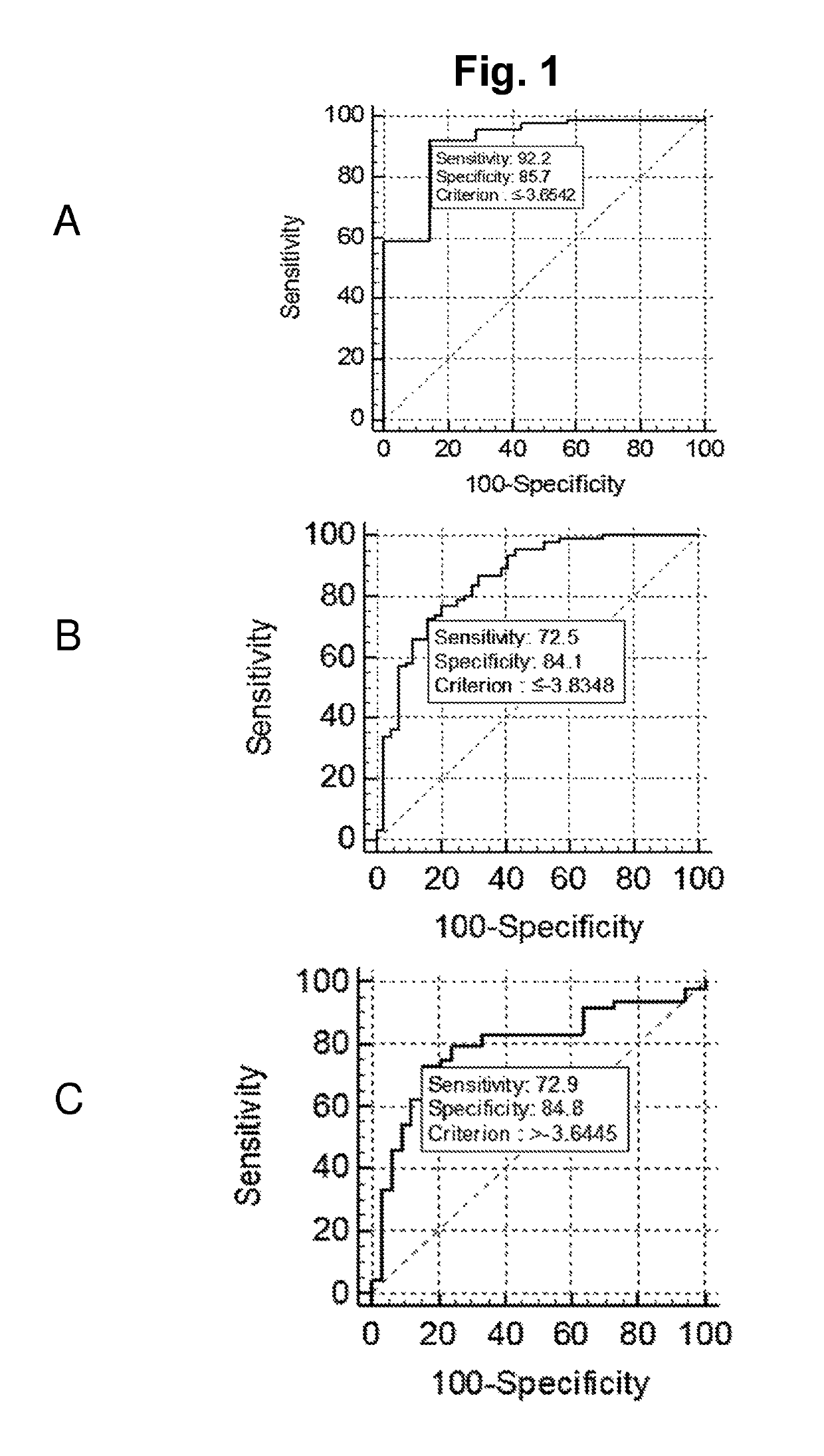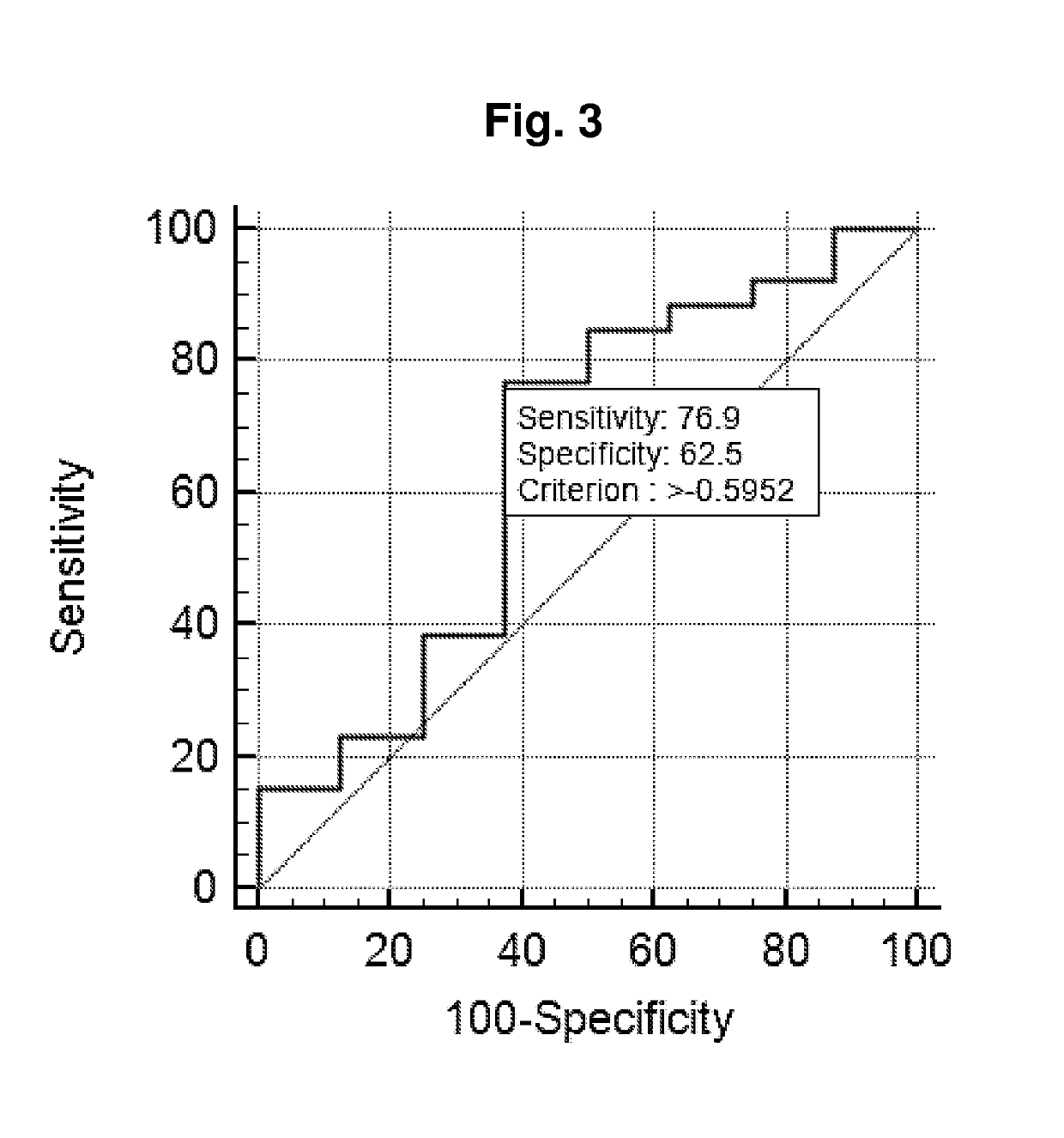MicroRNA-based method for early detection of prostate cancer in urine samples
a microrna-based, urine-based technology, applied in biochemistry equipment and processes, instruments, hybridisation, etc., can solve problems such as a large number of false negatives
- Summary
- Abstract
- Description
- Claims
- Application Information
AI Technical Summary
Benefits of technology
Problems solved by technology
Method used
Image
Examples
example 1
Title: Pilot Study—microRNA Profiling in Exosome Fractionated Cell Free Urine
Aim of Study
[0105]To identify abundant microRNAs present in cell free urine samples from healthy individuals and prostate cancer patients (across different disease stages).
Specimens
[0106]All samples were collected at Department of Urology, Aarhus University Hospital, Denmark (from 1997-2005). The sample set consisted of duplicates of 12 non-malignant samples (NM; from Benign Prostate Hyperplasia (BPH) patients (controls), 33 patients sampled before undergoing curatively intended radical prostatectomy (RP) for histologically verified clinically localized PC (RP), and 8 patients with castration resistant PC (CRPC). 34 of these samples belongs to cohort 1 (Example 2).
Method
[0107]Urine samples were spun down and 4.5 ml supernatant were transferred to 5 mL CRYO tube and stored at −80° C. until use. RNA from exosomes were extracted from 3 ml urine supernatant using the miRCURY™ RNA Isolation Kit...
example 2
Title: Identification of Diagnostic Classifier that Discriminates Between Healthy Controls and PC Cases
Aim
[0110]To identify microRNAs with diagnostic biomarker potential in urine samples from prostate cancer patients (PC) and healthy controls.
Specimens
[0111]All urine samples were collected at Department of Urology, Aarhus University Hospital, Denmark (from 1997-2005). The training cohort (cohort 1) consisted of 8 non-malignant samples (NM; from BPH patients (controls), 122 samples from patients who have undergone curatively intended RPs of histologically verified clinically localized PC 5 Castration Resistant Prostate Cancer (CRPC). See table 2 for overview of sample composition of cohorts.
[0112]
TABLE 2Patient composition of cohorts 1 and 2,CohortCohortMerged Discovery12Cohort (1 + 2)BPH84748CRPC535RP12298205RP + postEnd101
Method
[0113]Urine samples were spun down and 4.5 ml supernatant were transferred to 5 mL CRYO tube and stored at −80° C. until use. RNA from exo...
example 3
Title: Validation of the Diagnostic Performance of the 2 miR (Cp(miR-31-5p)-Cp(miR-30c)) Classifier
Aim
[0122]To verify the miRNA expression pattern of urine samples from PC patients compared samples from controls and validate the 2 miR (Cp(miR-31-5p)-Cp(miR-30c)) classifier identified in Example 2,
Specimens (Cohort 2)
[0123]All urine samples were collected at Department of Urology and obtained from Institute of Pathology, Aarhus University Hospital, Denmark (from 1997-2005). For all individuals sections of H&E stained formalin fixed paraffin embedded tissue specimens were evaluated by a trained pathologist. The validation cohort (cohort 2) consisted of 47 non-malignant samples (controls: BPH patients), 98 samples from patients with undergoing curatively intended RP for s of histologically verified clinically localized PC (RP) and 3 Castration Resistant Prostate Cancer (CRPC). See table 2 for overview of sample composition of cohorts
Method
[0124]As example 1,
MicroRNA E...
PUM
| Property | Measurement | Unit |
|---|---|---|
| PSA | aaaaa | aaaaa |
| threshold cycle | aaaaa | aaaaa |
| Ct | aaaaa | aaaaa |
Abstract
Description
Claims
Application Information
 Login to View More
Login to View More - R&D
- Intellectual Property
- Life Sciences
- Materials
- Tech Scout
- Unparalleled Data Quality
- Higher Quality Content
- 60% Fewer Hallucinations
Browse by: Latest US Patents, China's latest patents, Technical Efficacy Thesaurus, Application Domain, Technology Topic, Popular Technical Reports.
© 2025 PatSnap. All rights reserved.Legal|Privacy policy|Modern Slavery Act Transparency Statement|Sitemap|About US| Contact US: help@patsnap.com



